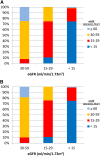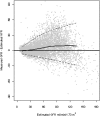Clinical Decision Making in a Patient with Stage 5 CKD--Is eGFR Good Enough?
- PMID: 25883071
- PMCID: PMC4633779
- DOI: 10.2215/CJN.00340115
Clinical Decision Making in a Patient with Stage 5 CKD--Is eGFR Good Enough?
Abstract
The development and widespread use of serum creatinine concentration-based prediction equations to calculate eGFR have been major advances for detection of patients with CKD and the epidemiologic study of CKD and its outcomes. However, these equations as well as those that also incorporate serum cystatin C concentration provide GFR estimates that, although reasonably precise on average, can differ markedly and in clinically important ways from actual GFR. Thus, it is important that clinicians who use these equations for clinical decision-making be familiar with their strengths and weaknesses and have an appreciation of their potential for error. More precise knowledge of actual GFR is important in certain clinical circumstances, including, as presented in this Attending Rounds, patients with stage 5 CKD, in whom decisions regarding dialysis initiation are necessary. Nephrologists should have the ability to accurately determine GFR when needed if clinical circumstances suggest inaccuracy of the calculated eGFR reported by the clinical laboratory.
Keywords: CKD; Cockcroft–Gault; ESRD; GFR.
Copyright © 2015 by the American Society of Nephrology.
Figures


Similar articles
-
Routine reporting of estimated glomerular filtration rate (eGFR) in African laboratories and the need for its increased utilisation in clinical practice.Niger Postgrad Med J. 2013 Mar;20(1):57-62. Niger Postgrad Med J. 2013. PMID: 23661212
-
Creatinine- vs. cystatin C-based equations compared with 99mTcDTPA scintigraphy to assess glomerular filtration rate in chronic kidney disease.J Nephrol. 2012 Nov-Dec;25(6):1003-15. doi: 10.5301/jn.5000083. J Nephrol. 2012. PMID: 22322818
-
[Evaluation of the applicability of three prediction equations for estimating glomerular filtration rate in children with chronic kidney disease].Zhonghua Er Ke Za Zhi. 2010 Nov;48(11):855-9. Zhonghua Er Ke Za Zhi. 2010. PMID: 21215031 Chinese.
-
GFR decline as an end point for clinical trials in CKD: a scientific workshop sponsored by the National Kidney Foundation and the US Food and Drug Administration.Am J Kidney Dis. 2014 Dec;64(6):821-35. doi: 10.1053/j.ajkd.2014.07.030. Epub 2014 Oct 16. Am J Kidney Dis. 2014. PMID: 25441437 Review.
-
[Consensus document: recommendations for the use of equations to estimate glomerular filtration rate in children].An Pediatr (Barc). 2014 May;80(5):326.e1-326.e13. doi: 10.1016/j.anpedi.2013.06.013. Epub 2013 Sep 20. An Pediatr (Barc). 2014. PMID: 24055321 Spanish.
Cited by
-
Timing of Kidney Replacement Therapy among Children and Young Adults.Clin J Am Soc Nephrol. 2023 Aug 1;18(8):1041-1050. doi: 10.2215/CJN.0000000000000204. Epub 2023 Jun 6. Clin J Am Soc Nephrol. 2023. PMID: 37279903 Free PMC article.
-
Estimated glomerular filtration rate in observational and interventional studies in chronic kidney disease.J Nephrol. 2024 Apr;37(3):573-586. doi: 10.1007/s40620-024-01887-x. Epub 2024 Feb 12. J Nephrol. 2024. PMID: 38347343 Free PMC article. Review.
-
Quantifying Glomerular Filtration Rates in Acute Kidney Injury: A Requirement for Translational Success.Semin Nephrol. 2016 Jan;36(1):31-41. doi: 10.1016/j.semnephrol.2016.01.008. Semin Nephrol. 2016. PMID: 27085733 Free PMC article. Review.
-
Rethinking CKD Evaluation: Should We Be Quantifying Basal or Stimulated GFR to Maximize Precision and Sensitivity?Am J Kidney Dis. 2017 May;69(5):675-683. doi: 10.1053/j.ajkd.2016.11.028. Epub 2017 Feb 20. Am J Kidney Dis. 2017. PMID: 28223001 Free PMC article. Review.
-
Role of Estimated Glomerular Filtration Rate in Clinical Research: The Never-Ending Matter.Rev Cardiovasc Med. 2024 Jan 4;25(1):1. doi: 10.31083/j.rcm2501001. eCollection 2024 Jan. Rev Cardiovasc Med. 2024. PMID: 39077647 Free PMC article. Review.
References
-
- Kidney Disease: Improving Global Outcomes (KDIGO) CKD Work Group: KDIGO 2012 clinical practice guideline for the evaluation and management of chronic kidney disease. Kidney Int Suppl 3: 1–150, 2013
-
- Schwartz GJ, Work DF: Measurement and estimation of GFR in children and adolescents. Clin J Am Soc Nephrol 4: 1832–1843, 2009 - PubMed
-
- Israni AK, Kasiske BL: Laboratory assessment of kidney disease: Glomerular filtration rate, urinalysis, and proteinuria. In: Brenner and Rector's The Kidney, edited by Taal MW, Chertow GM, Marsden PA, Skorecki K, Yu ASL, Brenner BM, Philadelphia, PA, Elsevier, 2012, pp 868–896
Publication types
MeSH terms
LinkOut - more resources
Full Text Sources
Other Literature Sources
Medical
Research Materials
Miscellaneous

